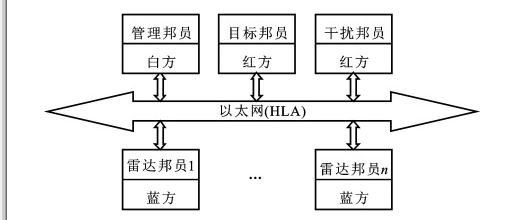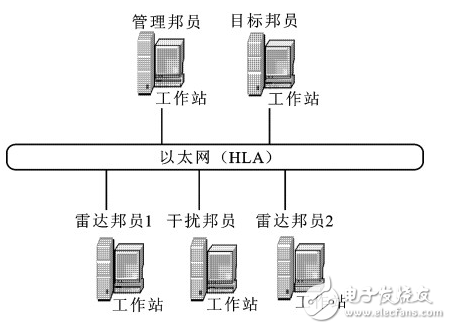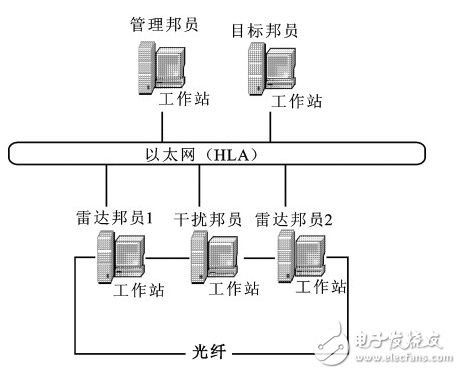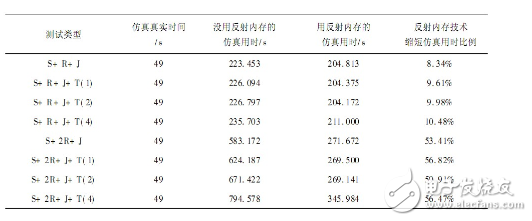With the development of computer and simulation technology, a signal-level radar countermeasure digital simulation system was established to study the effect of different interference patterns, thereby selecting effective interference patterns as weapons system countermeasure equipment, saving manpower and material resources, and shortening interference patterns and equipment. The development cycle.
2 HLA-based radar countermeasure digital simulation system2.1 The composition of radar countermeasure digital simulation system
Currently, HLA (High Level Architecture) has replaced DIS (Distributed InteracTIve SimulaTIon) and has become the mainstream advanced technology of distributed simulation. HLA is a new simulation technology framework proposed by the U.S. Department of Defense in 1995. Its distinguishing feature is the use of a generic, relatively independent supporting service program provided by a Run TIme Infrastructure (RTI) to emulate the application layer and the bottom layer. The support environment function is separated. In September 2000, the IEEE positioned HLA as an open standard, the IEEE1516 standard. The general architecture of the radar countermeasure digital simulation system is shown in Fig. 1 [1]. It is composed of the following federal members: the manager of the state, the radar state composer (a number of radar networks), the target statesman, and the interfering statesman.

Figure 1 The federal architecture of radar simulation system
According to Figure 1, the main physical models and functions of radar countermeasures for digital simulation systems are as follows: The red target uses a certain type of missile as the background, and the radar surveillance network composed of blue parties is penetrated; red interference engine: emits some interference signals ( If there is a false target interference, etc.), carry out the corresponding electronic countermeasures.
Deceive the blue radar network to cover the burst defense; the blue radar network searches, tracks, and images the red bullet, providing accurate intercept point calculations for subsequent interception interception. White Management: Comprehensive management of the start, run, and finish of the entire simulation system, and the time advancement of the entire simulation system based on the time advancement method based on radar events.
2. 2 Data Protocol of Radar Counter Digital Simulation System
Data transmitted on Ethernet based on HLA-based distributed simulation system is mainly divided into object type data and interaction type data, and RTI is responsible for distribution and delivery. Figure 2 shows an HLA-based radar countermeasure digital simulation system. Data transmitted on Ethernet [2] are mainly longitude, latitude, acceleration in each direction, speed, angular velocity and angular acceleration in each coordinate, and interaction type data.

Figure 2 HLA-based radar countermeasure digital simulation system
Among the main data transmitted by HLA-based radar countermeasure digital simulation system on Ethernet, the transmission of interference interaction data is the largest load for the network [3]. Assume that the sampling frequency of a radar is 200MHz and the sampling time is 50ms.
The sample data is 10M. Considering that the radar three channels are used for data processing, each interaction between the interferer and the radar state must be transmitted.
For 30M data, assuming that the data type is a double-precision floating-point type, the interference between the interfering statesmen and the radar statesmen is 240MByte each time.
Data, which is 1920MBi t data. For 100Mega, the ideal result of full load transmission is that a data exchange needs at least 20s or more, and each step of the radar's simulation (usually tens of milliseconds) requires a gap between the radar stateman and the interfering nation. A data interaction, while Ethernet network load is large, the network data delay is large and the delay time is unpredictable. Therefore, in the HLA-based signal-level radar counter digital simulation system, the network data transmission is caused by the simulation efficiency is not high. One of the factors.
3 Application of Reflective Memory Technology in Radar Counter Digital Simulation SystemCompared with general-purpose network technologies, high-speed real-time networks are used in specific, relatively small ranges to achieve better performance than real-world simulations. At present, the representative high-speed real-time network is the reflective memory network of VMIC. Its basic principle is similar to distributed shared memory. Each computer node is equipped with a communication board with a memory. The node writes on-board memory through the optical fiber. Pass to other communication boards connected to the fiber, so that distributed nodes can share write data [4]. Take the VMIC 5565 reflective memory as an example, this technology has the following features:
(1) High-bandwidth: With theoretical bandwidth of 2.12Gbps, the transmission speed can reach 47. 1M By te/s (4 bytes package), 174MBy te/s (64 bytes package).
(2) Fast: Data is written to one node and written to all nodes on the network at the same time. Up to 256 nodes can be supported.
Small point delay, transmission delay in 4-node mode is only 1.2us. (3) Delay determination: network delay due to token ring technology
Transmission is OK. Because HLA-based signal-level radar counters digital Ethernet systems, Ethernet TCP/IP is the underlying data transmission method that causes network overload, causing unnecessary delays in the data transmission of the entire simulation system, thereby reducing the operation of the entire simulation system. effectiveness. Therefore, in order to solve this problem, the Ethernet-based radar countermeasure simulation system has been optimized, and the simulation framework of reflective memory network and HLA coexistence has been introduced, as shown in FIG. 3 .

Figure 3 Radar countermeasure simulation system based on HLA and reflective memory
Organizations such as management, targets, radar (networking), and interference compose HLA-based extranets. At the same time, radar (networking) and interfering state members form an intranet based on reflective memory networks. The intranet completes the large amount of data transmission between the radar and the interference (the original data exchanged between the radar and the interference needs to be transmitted through the Ethernet through the thunder), and the external network completes the transmission of other original data. Reflective memory technology is applied in the HLA-based radar countermeasure digital simulation system. It inherits the system framework of the HLA-based radar countermeasure simulation system, and solves the problem of low efficiency of Ethernet transmission. It not only exerts the interoperability and availability of HLA. The advantages of reusability have also played the advantages of high-speed transmission of large amounts of data in reflective memory networks. The introduction of reflective memory technology in the HLA-based radar countermeasure digital simulation system and the operation of radar against the digital simulation system
Efficiency is completely dependent on the operational efficiency of the target state observer, interfering statesman, and radar state model, and the effect of data transmission on the efficiency of the simulation system can be ignored.
4 Simulation resultsA radar countermeasure digital simulation system uses pRT I, VC++, and VMIC 5565 reflective memory network as a platform to perform simulations on HLA-based radar countermeasure digital simulation systems and radar-based digital simulation systems based on HLA and reflective memory coexistence. The comparison is shown in Table 1.
Table 1 Interference pattern simulation results

Note: S stands for State Manager, R stands for Radar State, 2R stands for 2 Radar Statesmen, J stands for Interfering Statesman, and T( n) stands for n Targets among the target states.
5 Concluding remarksIn this paper, the use of reflective memory technology instead of Ethernet communication technology is proposed to solve the problem of the large amount of data interaction between radar and interference in the widely used HLA-based radar countermeasure digital simulation system, which improves the simulation efficiency of the radar countermeasure digital simulation system. From the results of the application of reflective memory technology can be seen:
(1) The reflective memory technology is compatible with the HLA technology development environment.
(2) Reflective memory technology can improve the efficiency of radar countermeasure digital simulation system, especially in the case of radar networking, its effect is significant.
Hydrogen Energy Pressure Sensor
Hydrogen Energy Pressure Sensor,Quantum Energy Hydrogen Water,Hydrogen Energy Storage System,Energy Hydrogen Generator
Shenzhen Ever-smart Sensor Technology Co., LTD , https://www.fluhandy.com